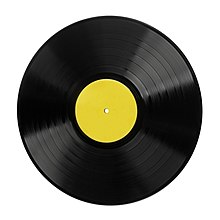
Back Доўгаіграючая пласцінка Byelorussian Дългосвиреща плоча Bulgarian LP Catalan Dlouhohrající deska Czech LP Danish Δίσκος βινυλίου Greek LP Spanish LP Estonian LP Basque آلبوم پرآهنگ Persian
 | |
 A 12-inch LP vinyl record Top: the original LP logo as used by Columbia Records | |
| Media type | Audio playback |
|---|---|
| Encoding | Analog groove modulation |
| Capacity | Originally 23 minutes per side, later increased by several minutes, much longer possible with very low signal level |
| Read mechanism | Microgroove stylus (maximum tip radius 0.001 in or 25 μm) |
| Developed by | Columbia Records |
| Dimensions | 12 inches (30 cm), 10 inches (25 cm), 90–240 g (3.2–8.5 oz) |
| Usage | Audio storage |
| Released | 1948 |
The LP (from long playing[1] or long play) is an analog sound storage medium, specifically a phonograph record format characterized by: a speed of 33+1⁄3 rpm; a 12- or 10-inch (30- or 25-cm) diameter; use of the "microgroove" groove specification; and a vinyl (a copolymer of vinyl chloride acetate) composition disk. Introduced by Columbia Records in 1948, it was soon adopted as a new standard by the entire US record industry and, apart from a few relatively minor refinements and the important later addition of stereophonic sound in 1957,[2] it remained the standard format for record albums during a period in popular music known as the album era.[3] LP was originally a trademark of Columbia[4] and competed against the smaller 7-inch sized "45" or "single" format by RCA Victor, eventually ending up on top.[5] Today in the vinyl revival era, a large majority of records are based on the LP format and hence the LP name continues to be in use today to refer to new records.[6][7]
- ^ "Origin of LP". merriam-webster.com.
- ^ "The history of the LP".
- ^ Zipkin, Michele (April 8, 2020). "Best albums from the last decade, according to critics". Stacker. Retrieved June 3, 2020.
- ^ "Columbia Records, Inc". Discogs. Retrieved August 19, 2024.
LP - Exclusive trade mark of Columbia Records Inc.
- ^ Evans, Mike (2022). Vinyl: The Art of Making Records. Simon and Schuster. p. 54. ISBN 9781645178163.
- ^ "Vinyl fans and traders tell of love for LPs as sales soar". BBC News. December 28, 2023. Retrieved May 5, 2024.
- ^ Sisario, Ben (October 21, 2021). "Vinyl Is Selling So Well That It's Getting Hard to Sell Vinyl". The New York Times. ISSN 0362-4331. Retrieved May 5, 2024.